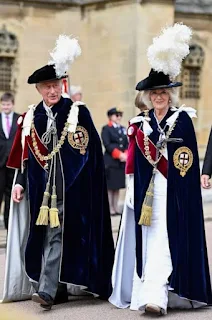 |
| Charles and Camilla at the Order of the Garter parade |
According to the palace's statement:
"The Coronation Ceremony will take place at Westminster Abbey, London, and will be conducted by the Archbishop of Canterbury. The Ceremony will see His Majesty King Charles III crowned alongside The Queen Consort. The Coronation will reflect the monarch’s role today and look towards the future while being rooted in longstanding traditions and pageantry".
 |
| King George VI and Queen Elizabeth at their coronation in May 1937. Their daughters, Princesses Elizabeth and Margaret, wore coronets |
The coronation of the new British monarch is a rare occasion to show the mesmerizing display of pomp and pageantry in full scale, complete with horse-drawn carriages, sparkling royal jewels, and splendid centuries-old royal tradition.
 |
| Queen Elizabeth II's coronation day in June 1953 |
 |
| The Queen and Prince Philip, Duke of Edinburgh |
The last time Britain had a grand coronation of a monarch was in June 1953 when Queen Elizabeth II was crowned at Westminster Abbey. However, unlike the Queen, the King's coronation is a bit different because his wife will also be crowned during the ceremony.
So what to expect during King Charles III's coronation next year? Here are some interesting factors to watch out, based on past coronation ceremonies.
The Crown Jewels
One of the most exciting displays of royalty during the monarch's coronation is the array of crowns and coronets that the royals will wear.
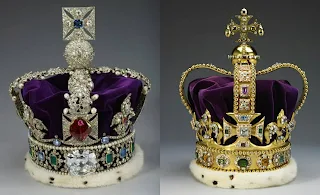 |
| Left: Imperial State Crown. Right: St. Edwardian Crown. Credit: Royal Collection Trust |
King Charles III will most likely wear the Imperial State Crown on his way to his coronation at the Abbey. But as with the previous British monarchs, he will be crowned using the St. Edwardian crown.
The British monarch only wears this sacred crown jewel ONCE - During the coronation day. After the ceremony, King Charles will remove the St. Edwardian crown and will wear the Imperial State Crown as he leaves the Abbey and return to Buckingham Palace for the balcony appearance. He will also carry a scepter and an orb during his coronation.
The Coronation of the Queen Consort
When the monarch is female, her husband is not titled "King". There's no provision in the constitution that grants a specific role for the Queen's husband other than Prince Consort. The last Queen regnant in the British monarchy who had a husband titled King was Queen Mary II. Her husband, Prince William of Orange, was her co-ruler as King William III.
 |
| State Diadem or George IV Diamond Diadem |
Queen Camilla will be crowned with her husband and she will most likely wear the King George IV Diamond Diadem, also known as the State Diadem, on her way to the Abbey. It's the crown that Queen Elizabeth II usually wore on state occasions during her long reign.
However, Queen Camilla will be crowned with a different jewel during the coronation ceremony. It is not known however what piece she will wear. Perhaps, she will just pick a piece from the royal collection as creating a new one sounds costly. She might just choose any of the following crowns worn by her predecessors.
 |
| Queen Alexandra, wife of King Edward VII, on their coronation day in 1902 |
 |
| Queen Mary's coronation crown in 1911. Credit: Royal Collection Trust |
 |
| Queen Elizabeth's coronation crown in 1937. Credit: Royal Collection Trust |
Description of Queen Elizabeth's coronation crown from The Royal Collection Trust's website: "It has a platinum frame set with 2,800 diamonds, mainly cushion-shaped but with some rose-cut and some brilliant-cut. The band, comprising alternating clusters formed as crosses and rectangles, is bordered by single rows of brilliant-cut diamonds and set at the front with a large diamond, which was given to Queen Victoria in 1856 by the Sultan of Turkey. Above the band are four fleurs-de-lis and four crosses-pattée. The front cross holds the Koh-i-Nûr diamond in a detachable platinum mount. The four tapering half-arches are removable and are surmounted by a pavé-set monde and a cross, set with a rock-crystal replica of the Lahore Diamond. Fitted with a purple velvet cap and ermine band"
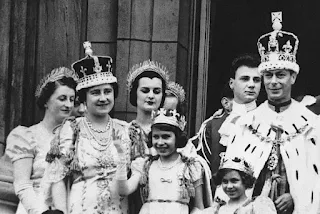 |
| Balcony appearance following the coronation in May 1937. Queen Elizabeth, Princess Elizabeth, Princess Margaret, and King George VI. |
The last time that the British monarchy had a Queen Consort was during the reign of King George VI. His wife, Elizabeth, was also crowned with him at Westminster Abbey.
According to The Royal Family's website:
"Unless decided otherwise, a Queen consort is crowned with the King, in a similar but simpler ceremony. If the new Sovereign is a Queen, her consort is not crowned or anointed at the coronation ceremony. After Queen Elizabeth II was crowned The Duke of Edinburgh was the first, after the archbishops and bishops, to pay homage to her"
Royal peers to pay homage
The peers of the realm will traditionally pay homage to the newly crowned monarch. And usually headed by the royal peers. Princess Anne is not part of this homage ceremony because she's not a member of the British peerage. The title Princess Royal is not a peer title.
During the coronation of Queen Elizabeth II, three royal dukes were the first to pay homage to her: Prince Philip, Duke of Edinburgh (her husband), Prince Henry, Duke of Gloucester (her paternal uncle), and Prince Edward, Duke of Kent (her first cousin).
It will most likely that the following royals will first pay homage to King Charles III on his coronation day: William, the Prince of Wales (his eldest son), Prince Edward, the Earl of Wessex (his younger brother), Prince Richard, the Duke of Gloucester (his uncle), and Prince Edward, the Duke of Kent (his uncle who is the only living royal duke who paid homage to Queen Elizabeth II).
Prince Harry, the Duke of Sussex, and Prince Andrew, the Duke of York, although members of the British peerage, and still royal dukes, are yet to be decided if they will be given prominent roles during the ceremony, considering their current circumstances.
Coronet of the Prince and Princess of Wales
Senior members of the Royal Family are expected to wear a coronet at the King's coronation. Prince William, the current Prince of Wales, declined to have his own investiture as Prince of Wales due to the increasing cost of living in the United Kingdom.
 |
| Prince of Wales coronet made for Prince George (later George V) at the coronation of his father, Edward VII, in 1902. Credit: The Royal Collection Trust |
His father, now the king, had an elaborate investiture ceremony in July 1969 at Caernarvon Castle in Cardiff, Wales, as Prince of Wales, and the ceremony was aired live on television. Charles was invested by his mother, the Queen, and was presented with a sword, a diamond-encrusted coronet, an amethyst ring, a rod, and a mantle.
 |
| The Prince of Wales coronet made for Prince Charles during his investiture as Prince of Wales in 1969 |
Prince William dismissed all the fancy elements of investiture due to the current inflation and economic challenges. However, on his father's coronation day, he is expected to wear a coronet. He might just choose any of these coronets.
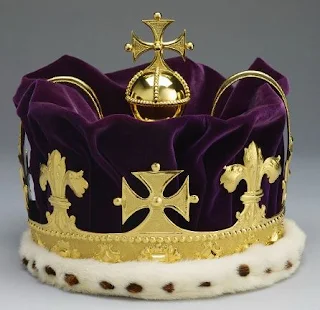 |
| The Prince of Wales coronet made for Prince Frederick, son of King George II |
According to the Royal Collection Trust website, "The coronet is composed of a silver-gilt frame, with a matted frieze decorated with partly or wholly polished jewel-like ovals and lozenges, each with an acanthus surround, above a ropework border. The upper border is continuous with four crosses-pattée and four fleurs-de-lis, partly matted and chased. The single arch is semi-circular with two borders of applied silver beads, supporting a matted monde surmounted by a cross"
 |
| The Prince and Princess of Wales during a visit to Belfast |
The Princess of Wales will also wear a coronet during the ceremony. Catherine will be the first Princess of Wales to attend a coronation of a British monarch since Queen Mary, the wife of King George V, attended the ceremony as Princess of Wales in 1902.
Prince George and Princess Charlotte of Wales
Will they attend the coronation of their grandfather? Most likely. George is nine and Charlotte will turn eight by the time the Coronation Day arrives next year.
 |
| Prince George and Princess Charlotte |
Although, we haven't heard so far that the minor grandchildren of the monarch ever attended a coronation ceremony in the past. Except for the children of the sovereigns. The Queen was 11 years old when her father, George VI, was crowned in May 1937. Her younger sister, Princess Margaret, was six years old. And they both attended the coronation ceremony wearing a coronet.
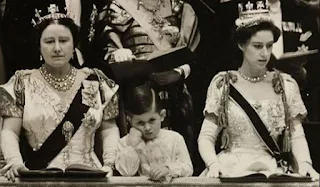 |
| Prince Charles was four when his mother was crowned in 1953. He was flanked by his grandmother, Queen Elizabeth, and aunt, Princess Margaret |
Prince Charles attended his mother's coronation ceremony in June 1953 but he did not wear a coronet. He was four years old then. His younger sister, Princess Anne, who was just two, did not attend the ceremony at Westminster Abbey but was present at the balcony appearance later.

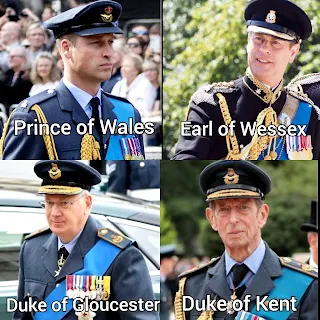





0 Comments